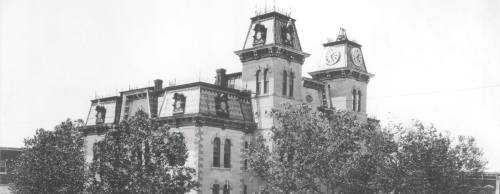Throughout its history the Historic Collin County Courthouse has reflected the growth of the city of McKinney.
The building was erected in 1875 after McKinney was named the county seat of Collin County. At the time, city leaders felt a prominent courthouse was needed to pay homage to the community that was developing as rail lines brought prosperity, reliable transportation and unprecedented growth to the city, according to the city of McKinney’s website.
Upon its completion the building was considered the tallest building in the state north of San Antonio, city officials said. In 1927 the courthouse was remodeled and nearly doubled in size. “Whenever you give men money, they like to build monuments,” said Guy Giersch, historic preservation officer for the city of McKinney.
The original courthouse, designed by Charles Wheelock in a second Empire French style, was built with an influx of money from the new railroads that ran through the area, bringing trade possibilities with it that had not existed before for McKinney, Giersch said.
In the years between 1875 and the Roaring ’20s, however, the county struggled to maintain the courthouse.
“There was a major economic recession after the Civil War that took place in the 1870s and really didn’t turn around until almost the end of World War I,” Giersch said. “So with less money you get less maintenance.”
In 1927 a major revitalization took place changing the courthouse into the Neoclassical Revival style designed by W.A. Peters, according to the city. That change in facade can still be seen today.
The courtrooms were used actively until 1979 when a new courthouse on McDonald Street was complete.
The last infamous murder trial to be tried in the historic courthouse, however, was held in 1980 when Candace Montgomery was tried for the murder of her next-door neighbor. Montgomery previously had an affair with the neighbor’s husband, said Amy Rosenthal, program director for the McKinney Performing Arts Center, which now operates within the courthouse.
The courthouse itself, however, was in rough shape at the time of the trial.
“Supposedly part of the roof fell down and crashed on the jury box a few days after the jury acquitted her,” Giersch said.
The courthouse sat awaiting new fate until 2006 when it was remodeled and transformed into MPAC, a multipurpose arts facility used for both public and private events.
“Our commitment to the state was that we would maintain and preserve the integrity of the courtroom,” Rosenthal said.
The integrity of the courtroom is in tact as the courtroom theater’s stage can be de-constructed in about a day and a half to convert the theater back into a courtroom, Rosenthal said. And occasionally that still happens as Judge Paul Raleeh holds night court sessions there, Giersch said.
For more information about MPAC or the Historic Collin County Courthouse, visit www.mckinneytexas.org.
Marthe Rennels contributed to this article.





